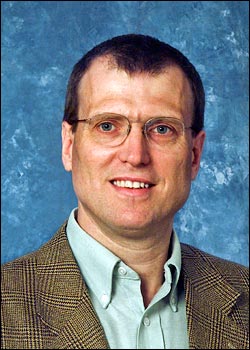Stony Brook University Launches Institute for Advanced Computational Science
Institute director Robert Harrison will also lead BNL’s Computational Science Center through joint appointment
August 6, 2012
UPTON, NY – Stony Brook University is launching a new world-class Institute for Advanced Computational Science, an innovative endeavor in which the Department of Energy’s Brookhaven National Laboratory will collaborate closely. The core mission of the Institute is to advance the science of computing and its applications to solving complex problems in the physical sciences, the life sciences, medicine, sociology, industry and finance.
The new Stony Brook institute will work with Brookhaven Lab’s Computational Science Center (CSC), which specializes in data-intensive computing. The collaboration will firmly establish the Stony Brook University-Brookhaven National Laboratory partnership as a center of excellence in high-performance computing and their shared commitment to building the future.
“We are especially pleased that this exciting endeavor further partners Stony Brook and Brookhaven National Laboratory,” said Stony Brook University President Samuel L. Stanley Jr. “BNL is a world leader in the storage and analysis of scientific data generated by its own facilities and the Large Hadron Collider at CERN. Together with BNL, Stony Brook has long been a partner in the New York State High Performance Computing Consortium, and New York State has generously supported our efforts to gain a leadership position in this rapidly emerging field.”
The new collaboration will also bring fresh leadership to the groundbreaking work conducted at both institutions. Robert Harrison, a distinguished expert in high-performance computing, joins Stony Brook as the founding director of the Institute for Advanced Computational Science. Through a joint appointment, Harrison has also been named the director of Brookhaven Lab’s CSC, where he will lead efforts in the fundamental and applied sciences, making use of the Lab’s supercomputers and other computing facilities deployed by the U.S. Department of Energy.
“Robert Harrison combines an extraordinary record of accomplishment in the mathematical and computational sciences with outstanding expertise using the high-performance computing systems at the very leading edge of technology,” said Reinhold Mann, BNL’s Associate Laboratory Director for Environment and Life Sciences. “We are excited about him leading our expanding efforts at BNL and this important partnership with Stony Brook University.”
Harrison comes to Long Island from the University of Tennessee and Oak Ridge National Laboratory, where he was Director of the Joint Institute of Computational Science, Professor of Chemistry, and Corporate Fellow. He has a prolific career in high-performance computing with over one hundred publications on the subject, as well as extensive service on national advisory committees. Harrison’s combination of experience made him an ideal candidate to launch this new initiative.
“This is another example of the close and impactful collaboration between the University and the Laboratory,” said Mann. “Both institutions have seen the need for some time to build up the expertise in high-performance computing and data-intensive computing. By joining our efforts, we are able to move farther and faster than either of us could separately.”
Supercomputers play an ever-increasing role in cutting-edge, cross-disciplinary research. From decoding the chemistry underlying the next generation of electric vehicle fuel cells to mining the particle collisions that unlock the secrets of the early universe, computing expertise and top technology are essential ingredients.
“Modern high-performance computers will soon reach the capability of performing a billion times a billion numerical operations per second,” said Harrison. “This breathtaking rate of computation will provide the means to compute problems of extreme complexity and enormous numerical scale. It will allow sifting through huge arrays of data, scanning images with billions of pixels, and finding the proverbial needle in a haystack in a reasonable time. I am looking forward to making Stony Brook University and BNL a valued partner with the federal government in its effort toward computational leadership.”
2012-11442 | INT/EXT | Newsroom










